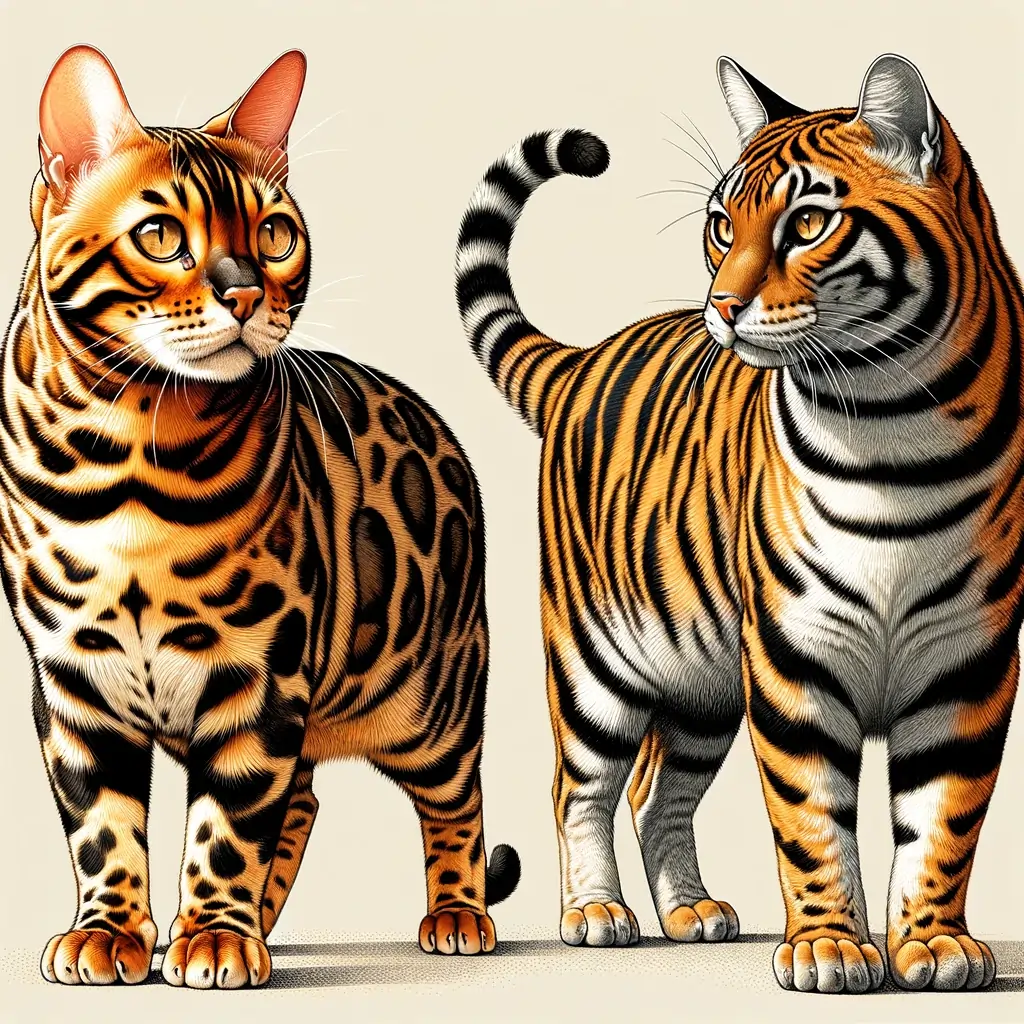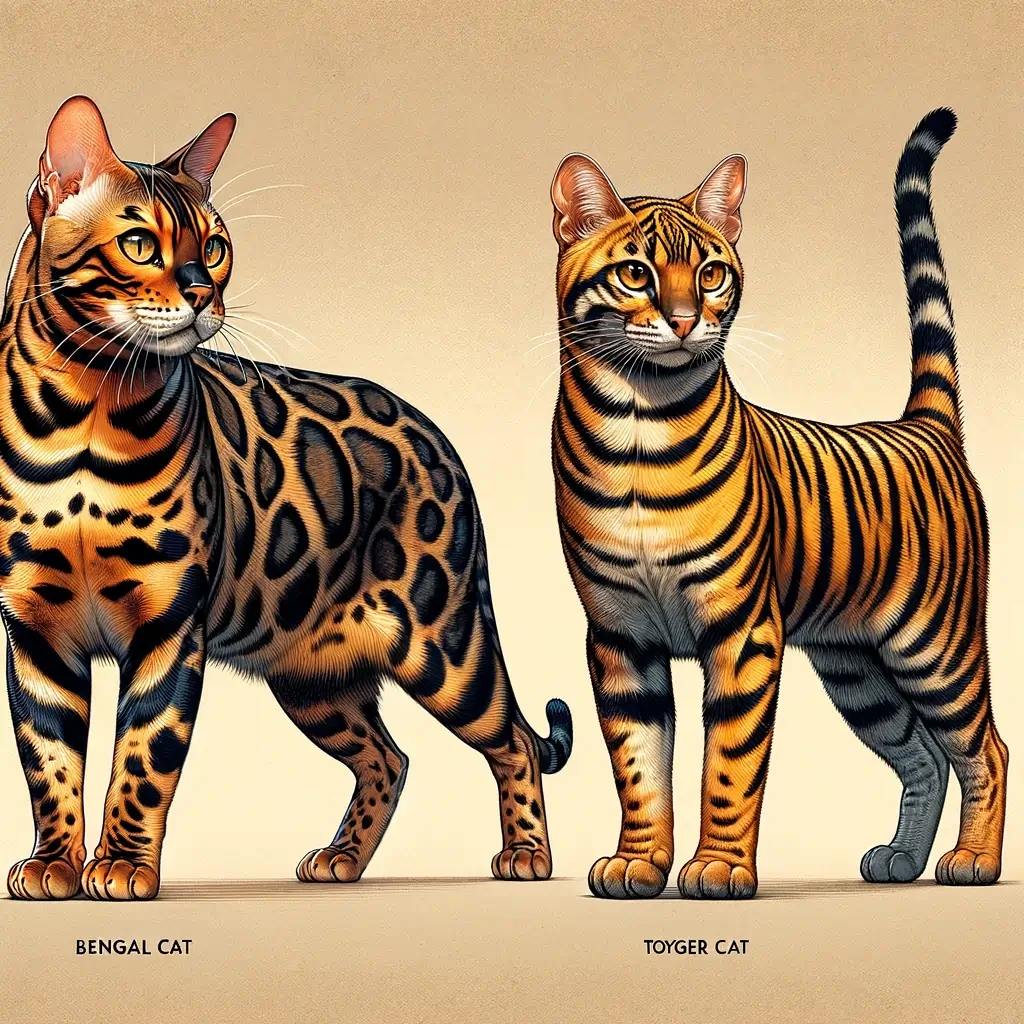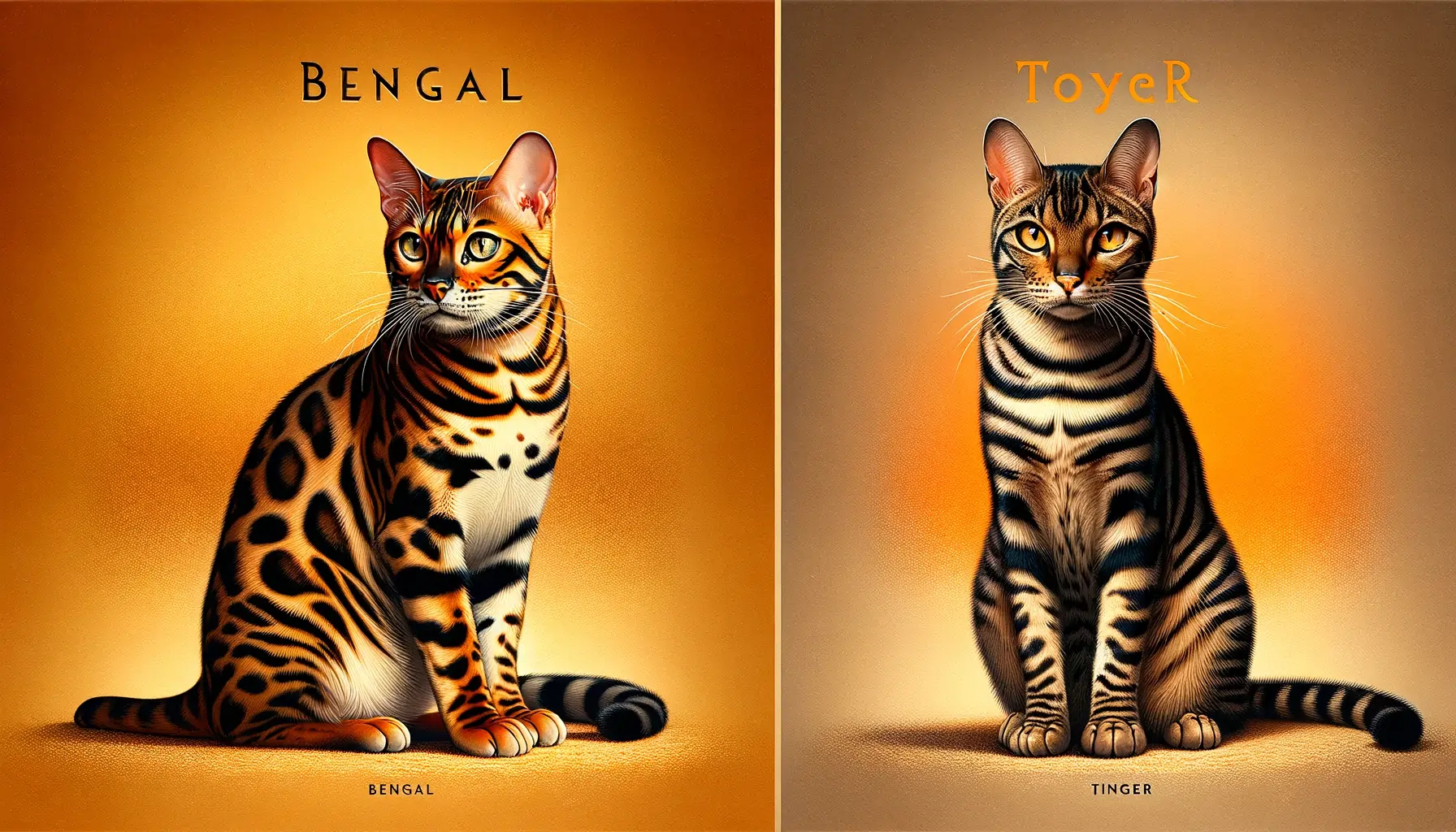In this article, we will compare and contrast Bengal vs Toyger, two popular cat breeds known for their unique traits and appearances. We will delve into their size, personality, and care needs to help you decide which breed is the right fit for your home.
Bengal vs Toyger Visual differences
| Feature | Bengal Cat | Toyger Cat |
|---|---|---|
| Origin | USA, cross between Asian Leopard Cat and domestic cats | USA, bred to resemble a toy tiger |
| Appearance | Leopard-like spots or marbled patterns, muscular build | Striped pattern, resembling a tiger, robust build |
| Size | Medium to large, 8-15 lbs | Medium, 7-15 lbs |
| Temperament | Active, playful, intelligent | Friendly, outgoing, intelligent |
| Maintenance | Moderate, needs regular play and interaction | Moderate, enjoys interactive play |
| Lifespan | 12-16 years | 12-15 years |
Bengal vs Toyger Overview
Let’s begin by looking at the Bengal cat and Toyger cat breeds individually. The Bengal cat is a domestic breed that was created by crossing an Asian leopard cat with a domestic shorthair cat. Known for their distinctive spotted or marbled coat patterns, Bengals are often described as miniature tigers. On the other hand, the Toyger cat is a rare breed that was developed in the 1980s by Judy Sugden. Toygers are bred to resemble a miniature version of a tiger, with their striped coat patterns and muscular build.
Bengal Cat Overview
The Bengal cat is a domestic breed that originated from crossing an Asian leopard cat with a domestic shorthair cat. The result is a breed with stunning coat patterns that resemble those of wild cats. Bengals have vibrant rosettes or marbled patterns on their coats, showcasing their unique heritage. Their coats come in various colors, including brown, silver, and snow. With their sleek bodies and agile movements, Bengals exhibit a remarkable resemblance to their larger, wild counterparts.
Toyger Cat Overview
The Toyger cat is a relatively new breed that was developed in the 1980s by Judy Sugden. Inspired by her love for tigers, Sugden aimed to create a domestic cat that resembled a miniature tiger. Toygers have bold black stripes that stand out against their bright orange or gold coats, mimicking the markings of a tiger. With their muscular build and striking appearance, Toygers capture the essence of their larger feline relatives.
| Breed | Origin | Distinctive Features |
|---|---|---|
| Bengal | Created by crossing an Asian leopard cat with a domestic shorthair cat | Spotted or marbled coat patterns |
| Toyger | Developed by Judy Sugden in the 1980s | Striped coat patterns |
Visual Differences
When comparing Bengals and Toygers visually, there are some noticeable differences. Bengals have a variety of coat colors, including brown, silver, and snow, with their distinct rosettes or marbled patterns. Toygers, on the other hand, have bold black stripes set against a bright orange or gold background, resembling a tiger’s coat. While both breeds share a wild appearance, Toygers may have a more striking resemblance to tigers due to their unique coat markings.

Bengal vs Toyger
Size and Personality
When comparing Bengal cats and Toyger cats, there are distinct differences in both size and personality. Bengals tend to be larger in size, weighing between 8 to 15 pounds as adults. On the other hand, Toygers typically weigh around 10 pounds. Here’s a comparison of the average size for each breed:
| Breed | Average Weight |
|---|---|
| Bengal | 8-15 pounds |
| Toyger | 10 pounds |
In terms of personality, both Bengal and Toyger cats are highly active and playful. However, there are some differences in their temperaments. Toygers are known to be more affectionate and inclined to seek out human companionship. They can be quite social and enjoy being around people. On the other hand, Bengals are known for their intelligence and independent nature. They are curious explorers and tend to exhibit more solitary behavior. It’s important to note that individual cat personalities can vary, regardless of breed.
Care Needs
When it comes to care needs, Bengals and Toygers have similar requirements. Both breeds have thick coats that need regular grooming to prevent matting. Regular brushing can also help minimize shedding and keep their coats healthy and shiny. It is recommended to use a comb or brush specifically designed for cats with thick fur.
In addition to grooming, Bengals and Toygers thrive on mental stimulation. These intelligent breeds need activities that engage their minds and keep them entertained. Interactive play sessions, puzzle toys, and training sessions are great ways to provide mental enrichment for your feline companions.
Regular veterinary check-ups are essential for both Bengal and Toyger cats. These visits allow the vet to monitor their overall health, administer necessary vaccinations, and address any potential health concerns. It is important to follow your veterinarian’s recommendations for vaccinations, deworming, and flea and tick prevention.
Furthermore, providing a balanced and nutritious diet is crucial for the well-being of both Bengal and Toyger cats. Feeding them high-quality cat food that meets their specific nutritional needs is important to maintain their optimal health. Consult with your veterinarian for guidance on choosing the right diet for your furry friends.
To ensure the happiness and fulfillment of Bengal and Toyger cats, it is essential to create a stimulating environment for them. This can include providing scratching posts, climbing trees, and interactive toys. Creating vertical spaces for them to explore and relax can also be beneficial.

Conclusion
After exploring the differences between Bengal cats and Toyger cats, it’s clear that these two breeds offer unique characteristics and appearances. Both breeds, the Bengal and the Toyger, make excellent companions for cat lovers who are looking for a cat with a wild appearance.
The Bengal cat, with its distinct rosettes or marbled patterns, resembles a miniature tiger. On the other hand, the Toyger cat’s bold black stripes against an orange or gold background give it a striking resemblance to a tiger.
When choosing between the Bengal and the Toyger, it’s important to consider their size, personality, and care needs. Bengals are generally larger and known for their independent nature and intelligence. Toygers, on the other hand, are slightly smaller and are more affectionate, seeking out human companionship.
Both breeds require regular grooming to keep their thick coats mat-free and mental stimulation to keep them happy. Providing a stimulating environment with interactive play and enrichment opportunities, as well as regular veterinary care and a balanced diet, are essential for their overall well-being.
FAQs
Q: What are the key differences between Bengal and Toyger cat breeds?
A: Bengal cats are known for their wild tiger-like appearance and active personalities, while Toyger cats resemble miniature tigers and are more laid-back in temperament.
Q: How do the temperaments of Bengal and Toyger breeds differ?
A: Bengal cats are energetic, playful, and highly outgoing, whereas Toyger cats are usually more relaxed, affectionate, and calm.
Q: Which breed is right for me, Bengal or Toyger?
A: If you are looking for a highly active and intelligent cat that requires mental stimulation, a Bengal may be the right choice. On the other hand, if you prefer a more mellow and affectionate companion, a Toyger could be the perfect fit.
Q: Can Bengal and Toyger cats get along well with other pets?
A: Both Bengal and Toyger breeds can get along with other pets if introduced properly and given time to adjust to each other’s presence. Early socialization is key to fostering harmonious relationships.
Q: How can pet owners provide mental stimulation for their Bengal or Toyger cats?
A: Pet owners can keep their Bengal or Toyger cats mentally engaged by providing interactive toys, puzzle feeders, cat trees, and opportunities to learn tricks and commands.
Q: Do Bengal and Toyger cats require a lot of playtime?
A: Yes, both Bengal and Toyger breeds are active cats that enjoy playtime. Regular play sessions help keep them physically and mentally healthy, so it’s important for pet owners to schedule daily playtime with their feline companions.
Q: Can Bengal or Toyger cats be trained to walk on a leash?
A: Yes, with patience and positive reinforcement, Bengal and Toyger cats can be trained to walk on a leash. It’s important to use a harness specifically designed for cats and start training indoors before venturing outside.

Hey guys, My name is Simon Smith. I’m from Canada and live near Victoria
I live with my sweet family and have 20+ Ragdolls of different types. I love them as my own children. My profession is as a hotel manager.
I love to keep Ragdolls and grow their breeder case. I have 7 years of experience.
I’m an expert in cat care. So, I’m here to provide you with new information about my cats daily. This is my personal blog website, so I request that you kindly visit our site daily.
If you’re a Ragdolls lover and you have any questions or confusion about cats, text me on the Contact Us page or Gmail.
Thank u
